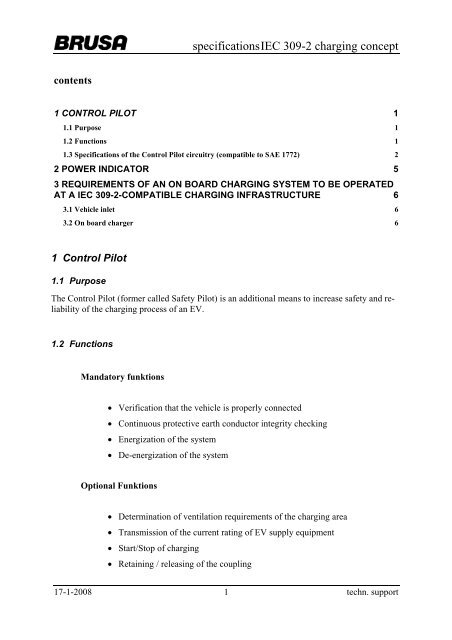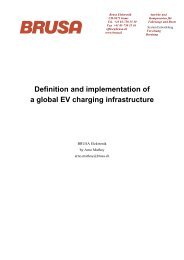specifications IEC 309-2 charging concept - Park & Charge
specifications IEC 309-2 charging concept - Park & Charge
specifications IEC 309-2 charging concept - Park & Charge
Create successful ePaper yourself
Turn your PDF publications into a flip-book with our unique Google optimized e-Paper software.
<strong>specifications</strong> <strong>IEC</strong> <strong>309</strong>-2 <strong>charging</strong> <strong>concept</strong><br />
contents<br />
1 CONTROL PILOT 1<br />
1.1 Purpose 1<br />
1.2 Functions 1<br />
1.3 Specifications of the Control Pilot circuitry (compatible to SAE 1772) 2<br />
2 POWER INDICATOR 5<br />
3 REQUIREMENTS OF AN ON BOARD CHARGING SYSTEM TO BE OPERATED<br />
AT A <strong>IEC</strong> <strong>309</strong>-2-COMPATIBLE CHARGING INFRASTRUCTURE 6<br />
3.1 Vehicle inlet 6<br />
3.2 On board charger 6<br />
1 Control Pilot<br />
1.1 Purpose<br />
The Control Pilot (former called Safety Pilot) is an additional means to increase safety and reliability<br />
of the <strong>charging</strong> process of an EV.<br />
1.2 Functions<br />
Mandatory funktions<br />
• Verification that the vehicle is properly connected<br />
• Continuous protective earth conductor integrity checking<br />
• Energization of the system<br />
• De-energization of the system<br />
Optional Funktions<br />
• Determination of ventilation requirements of the <strong>charging</strong> area<br />
• Transmission of the current rating of EV supply equipment<br />
• Start/Stop of <strong>charging</strong><br />
• Retaining / releasing of the coupling<br />
17-1-2008 1 techn. support
<strong>specifications</strong> <strong>IEC</strong> <strong>309</strong>-2 <strong>charging</strong> <strong>concept</strong><br />
1.3 Specifications of the Control Pilot circuitry (compatible to SAE 1772)<br />
P<br />
Control Pilot for <strong>IEC</strong> <strong>309</strong>-2 compatible <strong>charging</strong> station<br />
<strong>charging</strong> station<br />
feedback of actual state by changing the load impedance<br />
state A state B state C state D state X<br />
12V<br />
9V<br />
6V<br />
3V<br />
-12V<br />
1ms<br />
mode 1 or stand by vehicle detected ready with ventilation unknown impedance<br />
outlet<br />
L1 N<br />
CP PE PI<br />
<strong>IEC</strong> <strong>309</strong>-2 compatible<br />
transmission of the maximum mains current (ampacity) by PWM<br />
10A 16A 32A DC fast <strong>charging</strong> fault<br />
1kOhm Control Pilot 0,6V<br />
1kHz<br />
wallbox<br />
vehicle<br />
R1<br />
state<br />
A<br />
B<br />
C<br />
D<br />
value R1<br />
open<br />
2,7kOhm<br />
880 Ohm<br />
240 Ohm<br />
PE<br />
Control Pilot principle schematics<br />
16% 25% 50% 90%<br />
suitable for all currents up to 50A (78% duty cycle)<br />
Vehicle detection<br />
The load impedance on the vehicle side consists of a resistor, connected in series with a diode.<br />
The negative half wave of the control pilot signal remains unloaded. Therefore the wall<br />
box can distinguish between the presence of a vehicle and an unintended turn on request e.g.<br />
caused by a wet finger.<br />
Information from the vehicle to the wallbox<br />
Communication from the on board charger to the wallbox is provided by changing of the load<br />
impedance. Totally four operating states (A, B, C and D) one idle state (I) and one error state<br />
(X) are possible:<br />
17-1-2008 2 techn. support
<strong>specifications</strong> <strong>IEC</strong> <strong>309</strong>-2 <strong>charging</strong> <strong>concept</strong><br />
State definition by load impedance at the vehicle side (source resistance of the control<br />
pilot signal is constant at 1kOhm<br />
state load condition<br />
reaction of the <strong>charging</strong><br />
station<br />
control pilot signal<br />
I<br />
any load<br />
An <strong>IEC</strong> <strong>309</strong>-2 connector<br />
was plugged in; detection<br />
by a microswitch<br />
No energization before<br />
pressing the start button<br />
-12V static<br />
A<br />
open<br />
end<br />
no Control Pilot communication.<br />
Energization after pressing<br />
the start button. Line<br />
current limited to<br />
16A. Mode 1 <strong>charging</strong><br />
1kHz, duty cycle depends<br />
on ampacity<br />
positive 12V, pulse<br />
Once a control pilot communication was established, state A will deenergize the system<br />
and not allow mode 1 <strong>charging</strong>. The <strong>charging</strong> process could proceed at any time by reestablishing<br />
one of the active states (C or D) of the control pilot circuit.<br />
B<br />
2,7kΩ<br />
+diode<br />
A mode 3 compatible<br />
vehicle has been connected<br />
but is not ready for<br />
energy delivery.<br />
The vehicle is detected<br />
and the <strong>charging</strong> station<br />
waits for transition to C.<br />
1kHz, PWM, 1kΩ internal<br />
resistance<br />
positive 9V, pulse<br />
C<br />
880Ω<br />
+diode<br />
A mode 3 compatible<br />
vehicle is connected and<br />
ready for energy delivery.<br />
The direct transition<br />
from A to C without the<br />
intermediate step B is<br />
also allowed.<br />
Mains will be delivered<br />
to the socket outlet protected<br />
by a 32A line fuse<br />
The continous current is<br />
equal to the ratet value<br />
1kHz, PWM, 1kΩ internal<br />
resistance<br />
positive 6V, pulse<br />
negative -12V, any state<br />
D<br />
240Ω<br />
+diode<br />
Same as C with the requirement<br />
that ventilation<br />
of the <strong>charging</strong> place<br />
must be switched on.<br />
Outdoor same as C. If no<br />
sufficient vent. could be<br />
guaranteed, no energy<br />
delivery is allowed.<br />
1kHz, PWM, 1kΩ internal<br />
resistance<br />
positive 3V, pulse<br />
Releasing the mechanical switch causes immediate deenergization and produces a master<br />
reset. A new start pulse is necessary to reestablish charge again.<br />
Interruption of the control pilot circuit causes deenergitation without a master reset.<br />
(transition to state A with immediate deenergization)<br />
X<br />
R between<br />
200Ω<br />
and<br />
5kΩ<br />
The load impedance is<br />
in the range of valid values<br />
but the diode is<br />
missing.<br />
No energization. The error<br />
is indicated by an optical<br />
signal. From any<br />
other state: deenergization<br />
without reset.<br />
negative less than -12V,<br />
pulse<br />
17-1-2008 3 techn. support
<strong>specifications</strong> <strong>IEC</strong> <strong>309</strong>-2 <strong>charging</strong> <strong>concept</strong><br />
Information from the wallbox to the vehicle<br />
The maximum allowed mains current is indicated by the duty cycle of the control pilot signal.<br />
In the US the duty cycle of the control pilot signal indicates the rated current of the actual<br />
connection including socket outlet (if any), cable and vehicle inlet. It prevents the on board<br />
<strong>charging</strong> system from re<strong>charging</strong> at an insufficient source.<br />
For domestic <strong>charging</strong> at common outlets the control pilot generating unit is attached with the<br />
<strong>charging</strong> cable (mode 2).<br />
For Europe it is intended to use a modified <strong>IEC</strong> connector at the wall side both for domestic<br />
and public <strong>charging</strong> stations capable of delivering 32A. This connector has the same mechanical<br />
dimensions as the already existing single phase 16A device (coloured blue) but one of<br />
its 7 additional contacts is dedicated for the control pilot.<br />
Although the same signal forms are implemented to provide control pilot functionality, the information<br />
of the maximum current is used to adjust the on board <strong>charging</strong> system according<br />
to the given limit.<br />
However, a decrease of the default value of 32A will be an exception:<br />
• for a short period, to avoid undesired peak loads (the vehicle is used to balance<br />
mains load)<br />
• programmed by the user to gain low tariff facilities<br />
• permanently if the supply is rated for a lower than the default current e.g. domestic<br />
places<br />
Both approaches are compatible to each other. The US 60Hz 240V/208V source is basically<br />
compatible to the European single phase 50Hz 230V source.<br />
A car designed for the US market could be operated in Europe without any major changes<br />
of the on board <strong>charging</strong> system.<br />
Coding of the standard current values (<strong>IEC</strong> 38)<br />
current [A] 6 10 16 25 32<br />
duty cycle 25/256 5/32 1/4 25/64 1/2<br />
17-1-2008 4 techn. support
<strong>specifications</strong> <strong>IEC</strong> <strong>309</strong>-2 <strong>charging</strong> <strong>concept</strong><br />
By trying to relate simple duty cycles (8-bit system) to the <strong>IEC</strong> standard values a slight deviation<br />
to the US table occours:<br />
duty cycle USA Europe<br />
0,9 DC-quick charge DC-quick charge<br />
0,8 48A presently not used<br />
0,6 36A presently not used<br />
0,5 30A 32A<br />
0,4 24A 25,5A<br />
0,3 18A 19A<br />
0,25 15A 16A<br />
A car with an SAE1772 compatible on board charger will find the following values in Europe<br />
duty cycle USA Europa<br />
0,5 30A 32A<br />
0,39 23,4A 25A<br />
0,31 18.8A 20A<br />
0,25 15A 16A<br />
0,16 9,4A 10A<br />
2 Power Indicator<br />
The Power Indicator is important where the use of unspecific infrastructure with no control<br />
pilot facilities is desired. It is provided by an additional contact at the vehicle inlet.<br />
By putting a load impedance to ground on this contact, a lower input current value is required.<br />
(The default value where no control pilot communication takes place is 16A) The whole system<br />
works still under mode 1.<br />
17-1-2008 5 techn. support
<strong>specifications</strong> <strong>IEC</strong> <strong>309</strong>-2 <strong>charging</strong> <strong>concept</strong><br />
3 Requirements of an on board <strong>charging</strong> system to be operated at a<br />
<strong>IEC</strong> <strong>309</strong>-2-compatible <strong>charging</strong> infrastructure<br />
3.1 Vehicle inlet<br />
Besides the power contacts the vehicle inlet must at least provide one contact for the control<br />
pilot and should have another to enable the implementation of the power indicator.<br />
3.2 On board charger<br />
The on board charger should be able of a continuous variation of the input current. This<br />
would be a requirement if the control pilot is intended to be used adaptive.<br />
Further, it should provide an additional digital input for reducing the input power to a lower<br />
value<br />
common on board chargers designed for the european market with 3,6kW<br />
Only the power indicator would be necessary, because the default maximum current without<br />
control pilot communication is 16A<br />
However, a Control Pilot does provide additional safety and some countries may require this<br />
in the future<br />
On board chargers designed for the US market with input power greater than 3,6kW<br />
USA<br />
These chargers are equipped with the SAE 1772 Control Pilot. They are operated at the 240V<br />
supply system (two phases 120V with 180° phase displacement) or the 208V industrial supply<br />
system (two phases of a three phase 208V/120V). In both cases the potential of any life contact<br />
against ground will always be 120V AC.<br />
Europe<br />
Utilizing an european single phase supply, one of the life will become the neutral while the<br />
other one will carry the whole potential of 230V against ground. Overvoltage protection measurements<br />
should be examined because switching transients could reach then 700V easily.<br />
Utilizing the SAE 1772 Control Pilot in Europe<br />
If possible, the control pilot transmission of the ampacity should be used in an adaptive way<br />
in order not to interrupt the <strong>charging</strong> process, when lower power consumption is requested.<br />
Power Indicator<br />
It is assumed that existing systems will not provide an additional input. But these chargers<br />
operate only under mode 3 environment. Therefore, when operated at an unspecific outlet,<br />
they require always the generator in the cable which is called mode 2.<br />
If the charger is adaptive to the maximum current, the cable indicates the outlet for which it is<br />
designed for.<br />
17-1-2008 6 techn. support





